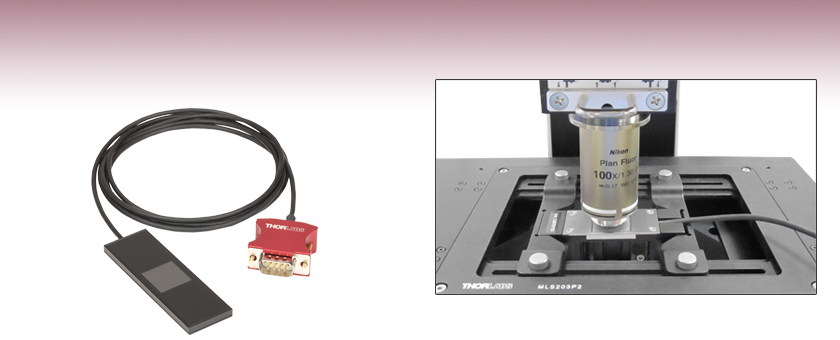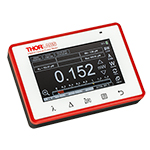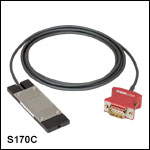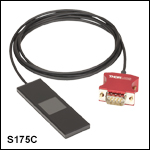Microscope Slide Power Meter Sensor Heads

- Measure Power at the Sample
- Large-Area Sensor to Collect Light from High NA Objectives (up to 1.45)
- Compatible with Dry, Water Immersion, and Oil Immersion Objectives
- Low- and High-Power Versions Available
S170C Microscope Slide Power Meter Sensor used with a 1.30 NA Objective and Shown on an MLS203-1 Motorized Scanning Stage Equipped
with an MLS203P2 Slide Holder
S175C
High-Power Microscope Slide Power Sensor for UV, Visible, and IR

Please Wait

Click to Enlarge
The back of the microscope slide sensor housing is engraved with the sensor specifications and a grid for centering the beam on the sensor. This image shows the engravings on the S170C; the engravings on the S175C are shown further below.

Click for Details
Using the engraved alignment target on the back of the sensor housing, a user can position the stage so that when the sensor is flipped, the beam strikes the center of the sensor. The S170C is shown in this image.
Features
- Compatible with Standard Upright and Inverted Microscopes
- Designed to Measure Power at the Sample Plane
- Large 18 mm x 18 mm Active Sensor Area
- Low-Power Photodiode Sensor (Item # S170C)
- Wavelength Range: 350 nm to 1100 nm
- Sensitive to Optical Powers from 10 nW to 150 mW
- High-Power Thermal Sensor (Item # S175C)
- Wavelength Range: 300 nm to 10.6 µm
- Measure Optical Powers from 100 µW to 2 W
- Sensor Housing with the Same Footprint as Standard Microscope Slides: 76.0 mm x 25.2 mm
- Novel Optical Design to Accommodate High NA Objectives (See Optical Design Tab)
- Information Stored in Connector:
- Sensor Data for Automatic Calibration when Using Thorlabs' Power Meter Consoles
(Sold Separately Below) - NIST- and PTB-Traceable Calibration Data
- Sensor Data for Automatic Calibration when Using Thorlabs' Power Meter Consoles
- Recalibration Service Available
Applications
- Measure Intensity of the Microscope Light Source at the Sample Plane
- Determine Transmission of a Fluorescence Filter Set
- Ensure Lighting Conditions are Consistent Between Experiments
Thorlabs' Microscope Slide Power Sensor Heads are designed to measure optical power at the sample in microscopy setups. These sensor heads have the same footprint (76.0 mm x 25.2 mm) as a standard microscope slide and are compatible with most standard upright and inverted microscopes. The sensors have a large active sensor area (18 mm x 18 mm); the low-power version incorporates a silicon photodiode sensor, while the high-power version is equipped with a thermal sensor.
The SC170C has a low-power sensor and is sensitive to wavelengths between 350 nm and 1100 nm at optical powers between 10 nW and 150 mW. A <1 µs response time makes this sensor ideal for high-resolution measurements using lasers, but it is still well suited for measurements of broadband illumination sources, like LEDs and white light sources. The S175C has a high-power sensor and is sensitive to wavelengths from 300 nm to 10.6 µm at optical powers between 100 µW and 2 W. This sensor features a flat absorptivity over the specified wavelength range, making it ideal for measurements of broadband illumination sources, like LEDs and white light sources. Please see the Specs tab for more information.

Click to Enlarge
The S175C connected to the PM400 touch screen power meter console (sold separately).
Day-to-Day Usage
The sensors support power measurements for objectives with NAs up to 1.45, and are usable in air and with water- or oil-based immersion media (see the Optical Design tab for details). As seen in the image above to the right, the back of the sensor is engraved with the recommended NA for air (<0.95), water (<1.30), and oil (<1.45) objectives. The active sensor area is protected by a glass cover surface, which can be easily cleaned using compressed air or using optic tissue moistened with acetone or methanol.
As seen in the image above, the bottom of the S170C and S175C sensors feature a laser-engraved alignment crosshair that marks the active sensor area to aid in aligning and focusing the beam. To use with a standard upright microscope, insert the housing into the beam path so that the engraved side is facing the objective of your microscope. Once the power sensor is centered under the objective, turn the slide over so that the detector is facing the beam in order to take a power measurement. For inverted microscopes, place the detector in your slide holder with the sensor facing the objective and turn on the trans-illumination lamp. Centering the beam on the engraved target will center the sensor in the optical path.
Power Meter Console Compatibility
These power sensor heads are compatible with the PM100D, PM100A, PM100USB, PM400, and PM320E power meter consoles. The PM100A, PM100D, and PM400 consoles are sold below for convenience. As seen in the image to the left, a 1.5 m cable attached to the side of the sensor head leads to a D-sub 9-pin male connector. Sensor specifications for automated calibration and the NIST- and PTB-traceable calibration data are stored in non-volatile memory in the sensor connector and can be read out using compatible Thorlabs power meter consoles.
Recalibration Service
Recalibration services are available for our power meter sensor heads. This service can be ordered below.
Click to Enlarge
Click Here for Raw Data
Typical responsivity curve for the silicon photodiode in the S170C. Note that this curve is representative, and the actual responsivity across the spectrum will vary from unit to unit. Measurements were made with a dry power meter without any water or oil immersion media.
| Specifications | ||
|---|---|---|
| Item # | S170C | S175C |
| Detector Type | Silicon Photodiode | Thermal Absorber |
| Wavelength Range | 350 - 1100 nm | 300 nm - 10.6 µm |
| Optical Power Working Range | 10 nW - 150 mW | 100 µW - 2 W |
| Max Average Power Density | 20 W/cm² | 200 W/cm² |
| Max Pulse Energy Density | - | 0.1 J/cm² (1 µs Pulse) 1 J/cm² (1 ms Pulse) |
| Linearity | ±0.5% | |
| Resolution | 1 nWa | 10 µWb |
| Calibration Uncertaintyc | ±3% (440 - 980 nm) ±5% (350 - 439 nm) ±7% (981 - 1100 nm) |
±3% (1064 nm) ±5% (300 nm - 10.6 µm) |
| Typical Application | Light Measurement on the Microscope Objective Plane | |
| Neutral Density Filter | Reflective (OD 1.5) | N/A |
| Cooling | Convection | |
| Console Compatibilityd | PM100D, PM100A, PM100USB, PM400, PM320E | |
| Response Time | <1 µs | <2 s |
| Overall Dimensions | 76 mm x 25.2 mm x 5 mm (2.99" x 0.99" x 0.20") |
76 mm x 25.2 mm x 4.80 mm (2.99" x 0.99" x 0.19") |
| Active Detector Area | 18 mm x 18 mm | |
| Input Aperture | 20 mm x 20 mm | 18 mm x 18 mm |
| Cable Length | 1.5 m | |
| Connector | Sub-D 9 Pin Male | |
| Weight | 0.07 kg (0.15 lbs) | 0.05 kg (0.11 lbs) |
| Post Mounting | 8-32 (M4) Thread | N/A |

Click to Enlarge
Click Here for Raw Data
Typical absorption curve for the S175C (glass and absorber). Note that this curve is representative, and the actual absorption across the spectrum will vary from unit to unit. Measurements were made with a dry power meter without any water or oil immersion media.
Sensor Connector
D-type Male

| Pin Connections | ||
|---|---|---|
| Pin | S170C | S175C |
| 1 | Not Used | |
| 2 | EEPROM Data | |
| 3 | Photodiode Anode and NTC Ground |
Sensor Ground |
| 4 | Photodiode Cathode | Not Used |
| 5 | Not Used | |
| 6 | EEPROM Ground | |
| 7 | NTC | Not Used |
| 8 | Not Used | Sensor Signal |
| 9 | Not Used | Not Used |
Cleaning
The housing of the S170C and S175C can be cleaned using a soft damp cloth. To clean the ND filter of the S170C, gently blow off any debris using compressed air. The surface may be gently wiped using an optic tissue moistened with acetone or methanol. The glass sensor cover of the S175C can be cleaned with appropriate solvents like isopropanol.
Calibration
The calibration of the sensors in the S170C and S175C should remain stable for over a year provided that the unit has not been exposed to excessive optical powers. We recommend yearly recalibration to ensure accuracy and performance, which may be ordered using the CAL1 (S170C) or CAL-S200 (S175C) item number below. Please contact Tech Support for assistance.

An illustration to show the behavior of light exiting a high NA objective after it enters the S170C microscope power sensor head vs. a typical photodiode sensor. For objectives with NAs greater than 1.0 and a detector without index matching gel in the gap, some of the light will also undergo total internal reflection at the ND filter-air interface, causing additional losses before the light reaches the sensor. (Important Note: Do not place immersion oil or other immersion media directly on the ND filter of any Thorlabs photodiode detectors other than the S170C, as they were not designed for this application and the oil cannot be cleaned from the filter surface.)
Large Active Area and Index Matching Gel
The S170C and S175C microscope slide sensor heads were designed with large-active-area detectors to accommodate high NA objectives. In addition, the S170C uses index matching gel in the gap between the neutral density filter and the sensor to minimize losses due to internal reflections at the air-glass interface. The S175C uses a protective glass cover that features a smaller air gap than the S170C (0.15 mm versus 1.5 mm) to avoid the use of index matching gel, which helps maintain a fast sensor response time.
The schematic to the right illustrates the advantages that a large-area detector like the one used in the S170C provides over typical photodetectors by tracing the path of light from a high NA objective after it enters an S170C microscope slide sensor head and a typical photodiode sensor. The typical photodiode sensor shown in the drawing has an air-filled gap between the ND filtera and the sensor and a Ø9.5 mm active area, similar to our S130 slim photodiode sensors or S120 standard photodiode sensors. When light from a large NA objective reaches the interface between the ND filter and the glass, it refracts away from the center of the sensor. Some of the light misses the edge of the small active area of the photodiode, causing erroneous power measurements.
In the S170C microscope slide sensor head, the gap between the neutral density filter and the sensor active area has been filled with an index matching gel. Compared to the ND-filter-to-air interface in typical sensor heads, the gel minimizes the amount of reflected light at the ND-filter-to-gel interface that would otherwise not reach the sensor and eliminates refraction of light exiting the ND filter, allowing the large-area detector to capture more light from the objective. Please be aware that this design cannot completely compensate for this effect for very high NA oil objectives and at certain wavelengths.
Similar results would be expected from a comparison of the S175C with other thermal sensors. The small 0.15 mm air gap between the protective glass plate and the thermal sensor minimizes the light refracted away from the center of the sensor, while the large 18 mm x 18 mm active area catches more of the incoming signal. Additionally, the S175C has a protective class cover plate that allows the appropriate immersion media for the objective to be applied without damaging the sensor. (Note: do not apply immersion media to Thorlabs' other thermal sensors, as it may damage to the sensor head.)
- Do not place immersion media directly on the ND filter of these photodiode sensors as it cannot be cleaned from the filter surface. The S170C is specifically designed for this application. The example used here is only intended to demonstrate the advantages of the S170C's optical design.
| Posted Comments: | |
user
(posted 2019-07-03 16:32:40.697) We are looking for a power meter similar to this but maybe one that is a cylinder as we are wanting to characterize an assembly that is illuminated from six points located around the circumference.
Please contact me. MKiess
(posted 2019-07-05 10:20:23.0) This is a response from Michael at Thorlabs. Thank you for your inquiry. I have contacted you directly to discuss further details on custom possibilities and applications for this sensor. g.makey
(posted 2016-05-12 03:50:55.7) Hi,
Can S170C be used in reflective mode microscope while imaging? shallwig
(posted 2016-05-12 05:05:39.0) This is a response from Stefan at Thorlabs. Thank you for your inquiry. I have contacted you directly to discuss how the S170C can be used in your setup. donovan.harris.civ
(posted 2015-12-10 15:28:18.217) Couldn't find compatible meter for the S175C. Using Zeiss compatible collimated LED sources at full power. shallwig
(posted 2015-12-11 06:41:50.0) This is a response from Stefan at Thorlabs. Thank you very much for your inquiry. The S175C sensor is compatible with any of our currently available consoles PM100D, PM100A, PM100USB, PM200, PM320E. I will contact you directly to discuss your application in more detail. cuhrich
(posted 2014-01-21 16:09:02.123) I just noticed that my comment is the same as one posted here. We need this device built with a stronger ND filter as we will have powers closer to 1W down on the sample. Seems like a reasonable option to offer a high power version. tschalk
(posted 2014-01-23 04:56:30.0) This is a response from Thomas at Thorlabs. Thank you very much for your inquiry. At the moment we are not able to equip the sensor with a stronger ND-filter because these does not meet our specifications. 1W is far away from the current specification and we hope to increase the maximum power level up to 300mW in the future. I will contact you directly to discuss your application. flickingerd
(posted 2013-11-01 08:24:21.293) A model with Pmax 500 mW would be nice (powers like this are normal for narrow bandwidth 2P microscopy). tschalk
(posted 2013-11-06 03:19:31.0) This is a response from Thomas at Thorlabs. Thank you very much for your inquiry. At the moment we can not provide a sensor with a higher power range because of the optical filter that is used. I will contact you directly to discuss your application and find a suitable solution. cbrideau
(posted 2013-08-01 16:38:44.763) Looking good, but how do you deal with the NA narrowing imposed by the Si detector's high index of refraction (>3)? |


Click to Enlarge
The S170C may be post mounted via the 8-32 (M4) tap in the side of the housing.
- Low-Power Photodiode Sensor for 350 - 1100 nm
- Designed to Measure Optical Powers from 10 nW to 150 mW
- Large 18 mm x 18 mm Sensor Active Area
- Ideal for Measuring Light from High NA Objectives or Any Position Along the Optical Path
- Yearly Recalibration with CAL1 Recalibration Service Recommended
(For More Information, Contact Technical Support) - Post Mountable via 8-32 (M4) Tap
The S170C Microscope Slide Power Meter Photodiode Sensor Head is designed to fit in the microscope slide holders of standard upright and inverted microscopes to measure the power at the sample plane. The active sensor is contained within a sealed housing, behind a neutral density (ND) filter with OD 1.5. A 20 mm x 20 mm indent above the ND filter accepts cover slips and immersion media. Immersion media (water, glycerol, oil, etc.) may be placed in this well directly over the ND filter, or a cover slip may be inserted first to simplify clean up. The S170C uses index matching gel in the gap between the neutral density filter and the sensor to minimize losses due to internal reflections at the air-glass interface. A detailed overview of these physical features is presented in the Optical Design tab. With a fast response time of 1 µs, minimum power of 10 nW, and resolution of 1 nW, this photodiode sensor is ideal for high-resolution power measurements of low-power illumination. The addition of water to a water dipping/ immersion objective always results in the absorption of some of the transmitted light, particularly in the near IR region. As such, power readings recorded without water will be higher than the values recorded with water.
The back of the slide is engraved with the sensor specifications and a grid for aligning the beam. To take a power measurement, simply flip over the slide to expose the sensor to the objective. In inverted microscopes, the trans-illumination lamp can be centered on the grid to ensure the sensor is centered on the beam.
Thorlabs recommends yearly recalibration of the S170C, which can be ordered through our CAL1 recalibration service. Enter the Part # and Serial # of the product that needs calibrating prior to Adding to Cart.


Click to Enlarge
The back of the S175C housing is engraved with the sensor specifications and a target for centering the beam on the sensor.
- High-Power Thermal Sensor for 300 nm - 10.6 µm
- Designed to Measure Optical Powers from 100 µW to 2 W
- Large 18 mm x 18 mm Sensor Active Area
- Ideal for Measuring Light from High NA Objectives or Any Position Along the Optical Path
- Yearly Recalibration with CAL-S200 Recalibration Service Recommended (For More Information, Contact Technical Support)
The S175C Microscope Slide Power Meter Thermal Sensor Head is designed to fit in the microscope slide holders of standard upright and inverted microscopes to measure the power at the sample plane. The large-active-area 18 mm x 18 mm sensor is protected by a glass plate, allowing immersion media to be applied. With a <2 s response time , 100 µW to 2 W optical power range, and 10 µW resolution, this thermal sensor is suited for high-power measurements of broadband sources, such as LEDs or white light illumination. The addition of water to a water dipping/ immersion objective always results in the absorption of some of the transmitted light, particularly in the near IR region. As such, power readings recorded without water will be higher than the values recorded with water.
The back of the slide is engraved with the sensor specifications and a target for aligning the beam, shown in the photo to the right. To take a power measurement, simply flip over the slide to expose the sensor to the objective. In inverted microscopes, the trans-illumination lamp can be centered on the target to ensure the sensor is centered on the beam.
Please be aware that thermal sensors are sensitive to air vents and strong ambient temperature changes. Measurements should be taken once the sensor has settled to the ambient temperature.
Thorlabs recommends yearly recalibration of the S175C, which can be ordered through our CAL-S200 recalibration service. Enter the Part # and Serial # of the product that needs calibrating prior to Adding to Cart.

Our most popular power meter consoles are included here for convenience. The PM100D digital power meter console features a back-lit LED screen and includes a 1 GB external SD memory card. The PM400 touch screen power meter console can perform the same functions as the PM100D with added features that include storing past power measurements in its 4 GB internal memory, inputs for external temperature and humidity sensors, programmable GPIO ports, and a capacitive touchscreen display that allows the unit to be operated with multi-touch gestures. Additionally, the PM400 allows optical power measurement data, temperature logs, spectral correction curves, and attenuation correction data can be saved by the user and transfered between the console and an external device for further analysis. These functions are particularly useful for tracking the consistency of the power at the sample plane over time.
For more information, click on the part number in the table below to view the complete presentation for each power meter console. The S170C and S175C sensors are also compatible with the PM100USB, and the PM320E consoles.
| Item # | PM100A | PM100D | PM400 |
|---|---|---|---|
| Console Image (Click the Image to Enlarge) |
 |
 |
 |
| Display | Mechanical Needle and LCD Display with Digital Readout |
320 x 240 Pixel Backlit Graphical LCD Display | Projected Capacitive Touchscreen with Color Display |
| Output | Analog Needle or Digital Numeric Readout | Numerical, Bar Graph, Statistics, Simulated Analog Needle |
Numerical with Bar Graph, Trend Graph (Power or Energy and Temperature), Statistics, Simulated Analog Needle |
| Calibration Functions | Wavelength Correctiona | Wavelength Correctiona | Wavelength Correctiona; Also Accepts User-Input Source Spectra and Attenuation Correction Data |
| Data Storage and Transfer | USB 2.0 Interface | 1 GB External SD Memory Card, USB 2.0 Interface |
4 GB Internal Memory Mini B USB 2.0 Interface |
| Dimensions | 7.24" x 4.29" x 1.61" (184 mm x 109 mm x 41 mm) |
7.09" x 4.13" x 1.50" (180 mm x 105 mm x 38 mm) |
5.35" x 3.78" x 1.16" (136.0 mm x 96.0 mm x 29.5 mm) |
| Display Dimensions | 1.9" x 0.5" (48.2 mm x 13.2 mm) Digital Display and 3.54" x 1.65" (90.0 mm x 42.0 mm) Analog Display |
3.17" x 2.36" (81.4 mm x 61.0 mm) |
3.7" x 2.1" (95 mm x 54 mm) |
 Products Home
Products Home















 Zoom
Zoom
 Microscope Slide Power Meters
Microscope Slide Power Meters